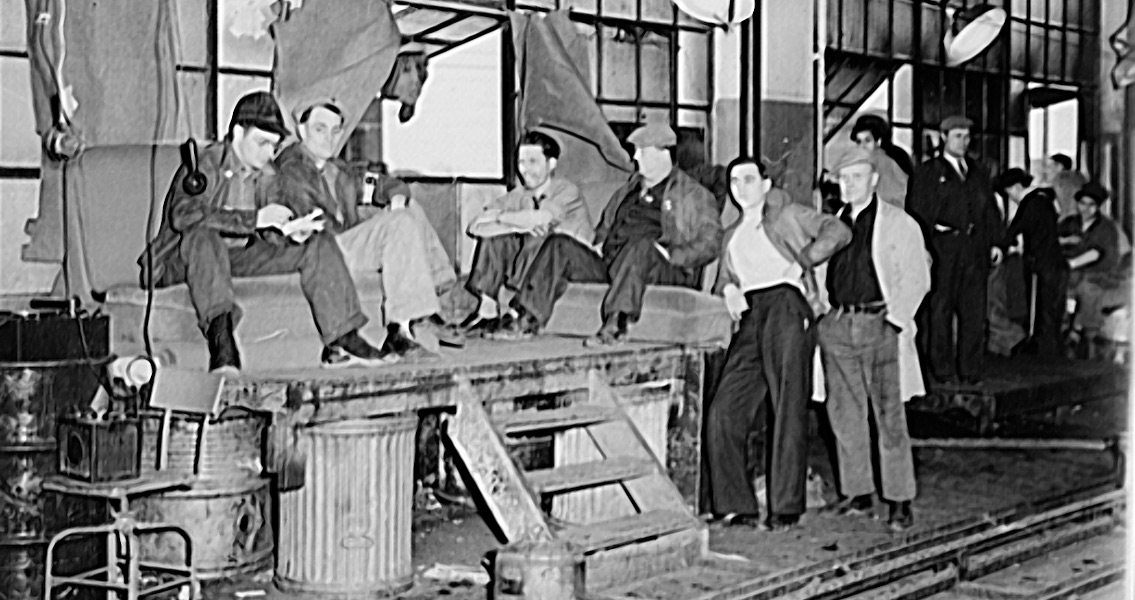<![CDATA[The first union strike in the history of the United States' automobile industry turned violent on 11th January, 1937. Twelve days into the Flint Sit Down Strike in Michigan, a riot broke out when police attempted to prevent food deliveries reaching the strikers occupying several General Motors plants. GM workers had started the strike on the evening of 30th December, 1936. At two body plants in the city of Flint: Buick Fisher Body No. 1, and Chevrolet Fisher Body No. 2, workers commenced their sit down strikes and occupied both of the factories. At this time Michigan was at the heart of the US auto industry, and General Motors was one of the 'Big Three' US car manufacturers, alongside Ford and Chrysler. The city of Flint was the centre of GM production, a company town where most of the stores and housing were owned by the car manufacturer and it was the only employer. Working conditions at GM and in the auto-industry in general were terrible in the 1930s, with a lack of coherent unionisation undermining workers' ability to bargain with their employers. Employees worked extortionate hours in atrocious conditions, with no extra pay for working overtime. In 1935, the average auto worker earned $900 annually. To place this salary into context, the United States government determined in 1935 that $1600 was the minimum with which a family of four could survive that year. In summer 1936, a wave of deaths in auto plants around Michigan, blamed on an unexpected heat wave and the poor conditions in the plants, pushed the workers towards action. America's auto-industry had gone to great lengths for years to prevent its employees from unionising. Thousands of dollars were spent by the companies on detective agencies designed to investigate their workers, and intimidate active union members. In addition, the Great Depression had improved the power of employers, weighting the labour market heavily in their favour and allowing them to threaten employees with dismissal if they unionised. Nevertheless, the movement for an auto industry union gathered strength. The Flint Sit Down Strikes were organised by the United Auto Workers Union (UAW) in an attempt to force GM to recognise the union as the exclusive bargaining authority of its workers. On top of this, the union hoped to win improved working conditions and greater job security. Sit down strikes were chosen because by occupying the factory itself, the workers prevented the company from simply replacing them. On top of that, the workers had shelter from the brutal Michigan winter, meaning their strike could go on indefinitely. In Flint Body Plant No. 2 the occupations proved particularly effective. The plant contained just one of two sets of body dies which GM needed on all cars that it manufactured. By taking the body plant, the strikers brought the production of the whole auto-giant to a standstill. The wives of the strikers had formed the Women's Emergency Brigade to supply food and drink to the men occupying the factories. The group was able to gather other supporters of the strike to aid in its efforts. GM cut off the plants' heating, hoping to freeze the strikers out. After that failed, the company pressured the authorities into a more aggressive strategy. On 11th January, the police attempted to cut off the food supply to Body Plant No. 2 by taking control of the gates leading into the complex. Violence erupted, and the police fired tear gas and buckshot at the strikers, who retaliated by launching car parts and water from fire hoses at them. Dozens of police and strikers alike were injured, but the plan ultimately failed. The Women's Emergency Brigade was able to continue organising the supply of food to those in the plant itself. Following the riot, the National Guard was called to Flint to maintain order, but the city's governor, Frank Murphy, stopped short of ordering them to forcefully break the strike, aware of the popularity of the strikers' cause. On 11th February 1937, the Flint Sit Down Strike finally came to an end when GM agreed to recognise the UAW as the sole bargaining agent for its workers. It proved a watershed moment, with the UAW organising subsequent strikes at other car manufacturers, and winning similar concessions. ]]>
Flint Sit Down Strike Descends into Tear Gas and Rioting
